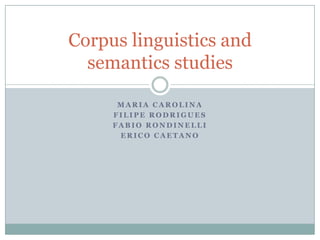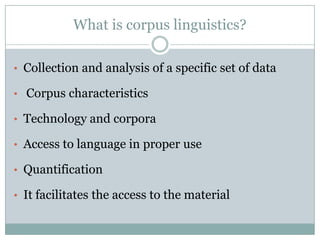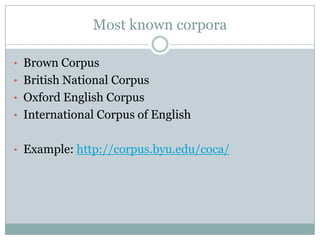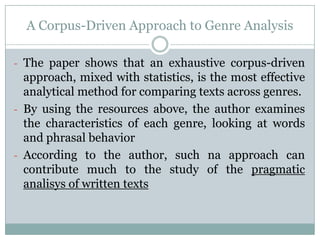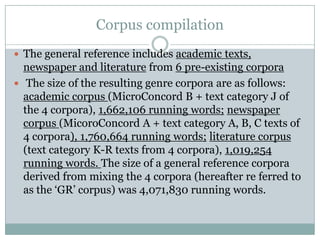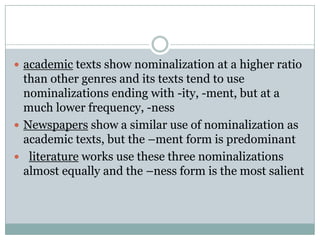Corpus and semantics final
- 1. M A R I A C A R O L I N A F I L I P E R O D R I G U E S F A B I O R O N D I N E L L I E R I C O C A E T A N O Corpus linguistics and semantics studies
- 2. What is corpus linguistics? • Collection and analysis of a specific set of data • Corpus characteristics • Technology and corpora • Access to language in proper use • Quantification • It facilitates the access to the material
- 3. Most known corpora • Brown Corpus • British National Corpus • Oxford English Corpus • International Corpus of English • Example: http://corpus.byu.edu/coca/
- 4. Corpus linguistics in semantic prosody “Prosody” in the term “semantic prosody” is borrowed from Firth (1957), who used it to refer to phonological colouring which spreads beyond semantic boundaries. To give an example, the word animal has so strong a nasal prosody that the vowel sound of the letter a is endowed with a nasal quality through assimilation, simply because a is closely adjacent to the nasal sound of n. In the same way, lexical items share this particular phenomenon of “prosody” in lexical patterning. Enlightened by Firthian sense of a “prosody”, Bill Louw coins the term “semantic prosody” and endows it with its first definition, a “consistent aura of meaning with which a form is imbued by its collocates” (Louw, 1993: 157).
- 5. Louw illustrates SP with several examples such as the adverbs utterly, the phrase bent on and the expression symptomatic of, which simultaneously carry negative SP. These three words are followed by expressions which refer to undesirable things, such as destroying, ruining, clinical, depression, multitude of sins, etc.
- 6. Semantics x Pragmatics Semantic meaning and pragmatic meaning are the two extremes in meaning system, for semantic meaning can be seen as the meaning which arises only from linguistic factors in a piece of communication, while pragmatic meaning is that meaning imposed by the non-linguistic elements which has an impact on communication
- 7. Studies on Corpus Linguistics and Semantics -Chishman and Teixeira (2009) provide us with an interesting study on nominal compounds based on Corpus Linguistics. -Data from 10 digital issues of National Geographic analyzed by a software. -It recalls a common question Brazilian students of English may ask: when trying to say “bolo de maça”, for instance, they may try “cake of apple” or even “apple‟s cake” before getting to “apple cake”, the correct nominal compound.
- 8. - Identification and categorization of recurrent semantic relations between nominal compounds. Examples: in memory drugs we find a relation of telicity, for those drugs aim at serving memory purposes. In school play, there is a relation of localization, while in rice bag the effect is of meronimy, for one element contains the other.
- 9. Such analysis could inspire us to observe the relation of compound nouns and even suggest that Brazilian students of English take a deeper look at them. For instance, what kind of relation would students find in the following compounds? How could they explain it with their own words? - car accident - fruit bat - skin cancer - island culture - lemon tree - cameraman - metal armor - ethanol production
- 10. A Corpus-Driven Approach to Genre Analysis - The paper shows that an exhaustive corpus-driven approach, mixed with statistics, is the most effective analytical method for comparing texts across genres. - By using the resources above, the author examines the characteristics of each genre, looking at words and phrasal behavior - According to the author, such na approach can contribute much to the study of the pragmatic analisys of written texts
- 11. Genres ď‚— Prior conceptions of genres considered external criteria. Biber(1988,1993) ď‚— With the new approach, genre can based on internal criteria ď‚— Instead of using a priori listings, genre can emerge through quantitative research in linguistics ď‚— Biber (1988) and the multianalytical approach: if some linguistic features are frequently in a text, other features will appear less frequently
- 12. Corpus compilation  The general reference includes academic texts, newspaper and literature from 6 pre-existing corpora  The size of the resulting genre corpora are as follows: academic corpus (MicroConcord B + text category J of the 4 corpora), 1,662,106 running words; newspaper corpus (MicoroConcord A + text category A, B, C texts of 4 corpora), 1,760,664 running words; literature corpus (text category K-R texts from 4 corpora), 1,019,254 running words. The size of a general reference corpora derived from mixing the 4 corpora (hereafter re ferred to as the „GR‟ corpus) was 4,071,830 running words.
- 13. Vocabulary variety and difficulty ď‚— The ranked order is, 1. newspaper, 2. literature and 3. academic. Therefore, both S-TTR and Guiraud values suggest that newspaper English uses the most varied vocabulary, literary English an intermediate one, and academic English the smallest, if estimators of lexical density are used. ď‚— The inclusion of longer words is taken to mean that texts have many difficult words from a solely empirical perspective - 1. academic, 2. newspaper and 3. literature.
- 14. N-Gram analisys ď‚— This analisys was done by comparing multi-word units between genre corpora, in particular 4-word units occurring in each genre corpus. Coniam (2004) used KfNgram (Fletcher 2002) to compute 4-word units occurring in specific genre texts taken from applied linguistics articles ď‚— N-grams are able to identify the commonest collocations in a discourse far more effectively than a single word analysis. There is an overall tendency toward using multi-word fixed units in academic texts as opposed to other genres.
- 15. Personality in texts: I, we and passives  Kuo researched the use of the personal pronoun in academic texts from an empirical viewpoint. The use of the personal pronoun provides an environment creating an interpersonal interaction between the writer and the readers (Kuo 1999:123)  Literature overuses “I”, while academic and newspapers underuse it. Academic and literature use “we” more often than newspapers.  The passive voice is much more used in academic texts
- 16. Nominalization  Biber et al. (1998:58) suggest that, “studying a morphological characteristic in a corpus can teach us both about the frequency and distribution of the characteristic and about the differing functions of particular variants”.  nominalization creates forms ending with -tion - sion, -ness, -ment and -ity, including plural forms.
- 17.  academic texts show nominalization at a higher ratio than other genres and its texts tend to use nominalizations ending with -ity, -ment, but at a much lower frequency, -ness  Newspapers show a similar use of nominalization as academic texts, but the –ment form is predominant  literature works use these three nominalizations almost equally and the –ness form is the most salient
- 18. References ď‚— ZHANG, Changu. An Overview of Corpus-based Studies of Semantic Prosody. Asian Social Science, vol. 6, June 2010. ď‚— CHISHMAN, Rove; TEIXEIRA, Lilian F. A semântica dos compostos nominais em lĂngua inglesa: um estudo de corpus. Veredas on-line – LinguĂstica de Corpus e Computacional, 2/2009, P. 84-99 ď‚— NISHINA, Yasunori (2007) “A Corpus-Driven Approach to Genre Analysis: The Reinvestigation of Academic, Newspaper and Literary Texts”, ELR Journal, 1 (2).

